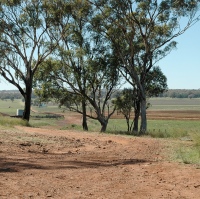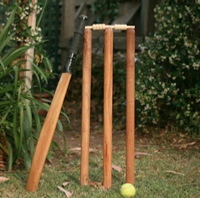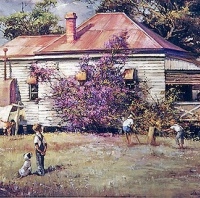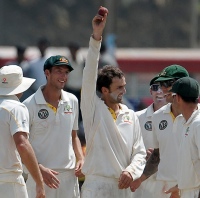- About Us
- Columns
- Letters
- Cartoons
- The Udder Limits
- Archives
- Ezy Reading Archive
- 2024 Cud Archives
- 2023 Cud Archives
- 2022 Cud Archives
- 2021 Cud Archives
- 2020 Cud Archives
- 2015-2019
- 2010-2014
- 2004-2009
 |
The Australian XI thrives On Bush Spirit |
In his playing days, Wisden editor Warwick Franks was a stubborn and courageous opening batsman. I remember his defiance in our clashes at a little bush cricket ground at Purlewaugh in the Coonabarabran district of north-western New South Wales. He would do anything to preserve his wicket and preferred to endure blows on the body rather than risk edging a catch to waiting fielders. These days when we meet we share views on the state of national cricket. An observer would probably think that we carry on like the retired pastoral worker who now only takes on ‘Shearing in the Bar’. Duke Tritton’s retired shearer finds that his ‘tally always doubles – and he never calls for tar’. In the reminiscences of former cricketers, there are no ducks, no dropped catches and no tiring days chasing leather.
Duke Tritton’s retired shearer finds that his ‘tally always doubles – and he never calls for tar’. In the reminiscences of former cricketers, there are no ducks, no dropped catches and no tiring days chasing leather.
Recently, Warwick informed me that Purlewaugh had a distant product on the verge of Test selection. Right arm off-spinner Nathan Lyon, whose father grew up in Purlewaugh, went to school in Young and played cricket in Canberra, but it was his career as a groundsman at Adelaide Oval that brought him into first class cricket and consideration for the national squad.
Lyon’s selection raised memories of cricket at Purlewaugh and of the Lyon family. The Purlewaugh ground was not well grassed. The boundary was marked by a mound that had been contour ploughed at a rough distance from the pitch. The sports complex doubled as PLP – a Public Watering Place set on the old TSR – Travelling Stock Route. Sometimes animals had to be evicted before play could begin. There might have been one bench for spectators. The home side always gathered under an old apple gum, the venue for the inevitable post-mortem which sometimes extended late into the night, assuming the beer supply in the ice chest held out. Cricket is thirsty work. If rain washed out the day’s play it didn’t really matter. You don’t need to be dry to drink beer, and the post-mortems then became a recounting of the antics during the previous week’s post-mortem. There was never any shortage of material. I tried to persuade them that someone should bring a welding machine to the ground because a great grandstand could be fashioned from the beer cans.
If rain washed out the day’s play it didn’t really matter. You don’t need to be dry to drink beer, and the post-mortems then became a recounting of the antics during the previous week’s post-mortem. There was never any shortage of material. I tried to persuade them that someone should bring a welding machine to the ground because a great grandstand could be fashioned from the beer cans.
The pitch was a trifle rough. Many visiting bowlers found the potholes impossible to negotiate safely and even batsmen were in danger. Once we batted first and got about 190. We felt confident enough until their opener despatched the first short ball for four through point then went better on the second sweeping a full toss for six over square leg. No-one could have predicted the drama on the third ball. The pitch was of concrete covered with green coir matting. Rumours had it that the bloke who laid the pitch was a batsman and wanted the keep the bowler away as far as possible and so made the pitch longer than the usual 22 yards and somewhat thinner than it should have been. Consequently, the coir matting covered a few inches either side of the narrow pitch, and over time, the soil had eroded away leaving a ledge on one side of the wicket under the mat. Well, the four and the six were followed by a nice drive down the ground. The batsmen looked set for two but on turning, the six-hitter twisted his ankle on the edge of the pitch hidden by the mat. He was assisted from the ground and took no further part. They did not make the required runs.
While the facilities were not great – there was just an old pit toilet for example – the hospitality at Purlewaugh was beyond question. As a young teacher arriving from the city, and unaccustomed to such a warm welcome I thought initially that there must have been something special about me! I soon realised however, that the locals treated all newcomers with respect and consideration and that these hospitable people were the special ones. I have very fond memories of the hot dry days around what was known as ‘Harvest Break’ when many regular players were confined to the cabins of their headers and boys returned from boarding schools to proudly take their places. I loved the swooping flocks of galahs cleaning up the grain spilled by trucks on the way to the silo at Ulamambri, the evening storms rumbling around the horizons, and the huge blue sky.
Nathan’s father Steve and his brothers played for Purlewaugh as though their lives depended on it. It was typical of the family’s approach to life generally. Their parents were wholly dedicated to their children and as the eight siblings went through St Lawrence’s School, Mum Lola was a tireless worker there, as she was in the Purlewaugh community. They were always spotlessly turned out, pleasant and polite. They really would have shared their last mouthful of food with anyone in need. I had the privilege of teaching some of them, and the story of how I came to be working in the Catholic school also has echoes of cricket at Purlewaugh. The day before my first match I got news that cricket that weekend was postponed. The cricket association’s president, also a teacher at St Lawrence’s was tragically killed in a firearms incident. Some months later, I made a life-changing decision to leave the education department and work in the Catholic system.
In his important book First Tests: Great Australian Cricketers and the Backyards That Made Them, Steve Cannane interviews many famous Test players of previous generations. Almost all of them remember the importance of backyards in sustaining their interest in the game. As backyards disappear, young cricketers will get their grounding somewhere else, if at all, and it is far from clear what effect this will have on their abilities and styles. Legend has it that Don Bradman’s unique skill was nurtured not by coaches but by his practice of using a cricket stump to hit a golf ball rebounding from a corrugated iron water tank with protruding studs.
The selection of Nathan Lyon in the Australian cricket team should be hailed by all true fans of the game. The team needs some old-fashioned bush enthusiasm. Many former great players had unpredictable rises through the ranks, without a great deal of coaching, grooming and pampering with contracts. Lyon had one of the most sensational debuts in Test cricket history. With his first ball against Sri Lanka he took a wicket, and got five wickets in all. Whether he continues to break records or not, all Australians should join everyone in Purlewaugh wishing Nathan Lyon success in his career. All of the now scattered Lyon family will be bursting with pride. It just goes to show that nice things can happen to nice people.
Tony Smith has written on defence and foreign policy issues in the Australian Quarterly, the Australian Review of Public Affairs, Eureka Street, Online Opinion and Unleashed.
